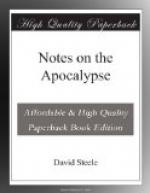It ought to be considered that all these seven churches were one church, as originally constituted, having the same,—that, is, a divine, scriptural organization. And although in the divine forbearance, they were still owned by Christ, notwithstanding the errors, heresies and immoralities which had crept into them; yet it is manifest that he threatens some of them with divorce, total extinction in case of impenitence. He has indeed fulfilled his awful threats in making them a desolation. Is it reasonable to suppose that he would reorganize these, or recognise others which incorporate the same or the like corruptions in doctrine and practice for tolerating which he has “removed their candlestick,” or “spued them out of his mouth?” (Absit blasphemia.) To say so, or write so, does not manifest the “charity which rejoiceth not in iniquity, but rejoiceth in the truth.” Alas! the present condition of the church general contains frequent evidences, that our Saviour’s affectionate counsels, solemn warnings, and awful threatenings, are neither duly pondered nor dutifully regarded.
CHAPTER IV.
With this chapter the prophetical part of the Apocalypse begins. This is the place where the third division of the book commences, of which intimation had been given to John.—“Write ... the things which shall be hereafter.” (Ch. i. 19.) The third is therefore much the largest part of the whole book, comprising all from the 4th to the 22d ch. It is also to be noticed that the fourth and fifth chapters are properly of the nature of an introduction to what follows, presenting to view, as it were, a grand theatre on which are to be exhibited the dramatic characters and events which constitute the outline of history in the church and the world from the apostle’s time till the consummation of all things.
Expositors commonly frame and lay down some rules by which they suppose symbolic language in general, and the symbols of this book in particular, may be interpreted. On examination, however, it will be discovered that the learned are not agreed either in the nature or number of such rules, and sometimes an expositor who has exerted his ingenuity most in devising canons of interpretation, forgets to apply them.
All languages, whether spoken or written, are more or less metaphorical, interspersed with what are called figures of speech. It is customary to represent nations and tribes, whose language abounds in symbols, as but little advanced in civilization; and to view oriental nations as more disposed to indulge in tropes and figures than those of the west; but perhaps this relative estimate of the modes of speech in the eastern and western hemispheres will admit of some modification, when we consider the gesticulations and similes by which the aborigines of America attempt to give expression to their ideas. The word hieroglyphics, signifying sacred sculpture, derived from the ancient mode of writing by the priests of Egypt, has received conventional currency among the learned, as descriptive of any writing which is obscure, “hard to be understood.” And all who read this book will find some of it “dark” indeed. The divine Author intended that it should be so, (ch. xiii. 18;) yet he calls it emphatically, a “Revelation.”




